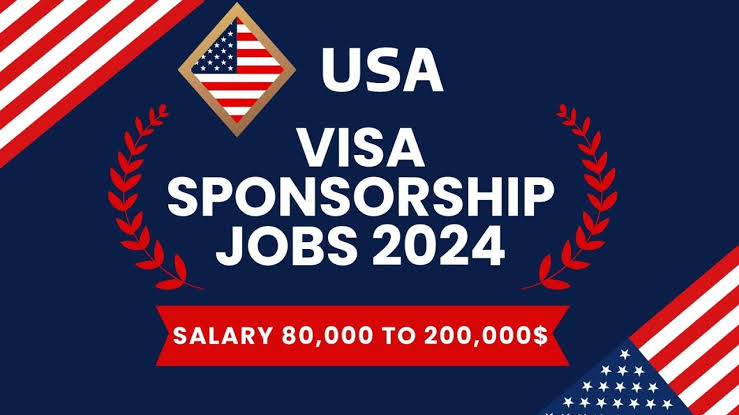U.S. Visa Sponsorship Opportunities in 2024/2025 – Submit Application Now

As the global community gradually emerges from recent challenges, the United States remains a beacon of opportunity for individuals and families worldwide. Navigating the intricate landscape of U.S. immigration can be overwhelming, especially for those seeking opportunities that involve visa sponsorship.
In this article, we will explore the diverse visa sponsorship opportunities available in the U.S. for 2024 and 2025. Whether you are a skilled professional seeking employment, a student pursuing higher education, or a family looking to start anew, understanding the range of visa options and sponsorship pathways is crucial. We will delve into the latest trends, policy changes, and the most in-demand sectors for sponsorship, providing you with essential information to plan your journey to the U.S.
Join us as we embark on this journey together and discover the opportunities that await you in the land of the free and the home of the brave in 2024 and 2025.
Who is Eligible for Visa Sponsorship?
Eligibility for visa sponsorship in the United States varies depending on the type of visa being sought. Generally, visa sponsorship is available for employment-based visas, family-based visas, and some types of educational visas. Here’s a breakdown of who is typically eligible for these categories:
Employment-Based Visas
- Skilled Professionals: Those with specialized skills, education, and work experience. Example: H-1B visa for occupations requiring specialized knowledge.
- Intra-Company Transferees: Employees of multinational companies being transferred to a U.S. branch. Example: L-1 visa for managers, executives, or those with specialized knowledge.
- Individuals with Extraordinary Abilities: Those who have demonstrated exceptional skill in areas such as science, arts, education, business, or sports. Example: O-1 visa.
- Investors and Entrepreneurs: Individuals who will invest in the U.S. economy or start a business. Example: E-2 visa for investors and EB-5 visa for immigrant investors.
- Specific Nationalities: Some visas are available to individuals from specific countries under special agreements. Example: E-3 visa exclusively for Australian citizens.
Family-Based Visas
- Immediate Relatives of U.S. Citizens: Spouses, unmarried children under 21 years old, and parents of U.S. citizens.
- Family Preference Categories: Includes adult children (married and unmarried) and siblings of U.S. citizens, and spouses and unmarried children (minor and adult) of U.S. permanent residents (Green Card holders).
Educational Visas
- Students: International students accepted into U.S. educational institutions. Example: F-1 visa for academic students and M-1 visa for vocational students.
- Exchange Visitors: Participants in approved exchange programs, including scholars, teachers, and interns. Example: J-1 visa.
General Requirements
- Valid Passport: Must have a passport valid for travel to the United States.
- Nonimmigrant Intent: For nonimmigrant visas, applicants must demonstrate that they intend to return to their home country after their temporary stay in the U.S.
- Financial Support: Must prove they can support themselves financially during their stay in the U.S.
- No Serious Criminal Record: Must not have serious criminal offenses and should pose no security risk to the U.S.
- Health Considerations: Must meet health and vaccination requirements.
Special Considerations
- Refugees and Asylees: Individuals fleeing persecution may be eligible for refugee or asylum status in the U.S.
- Diversity Visa Program: Citizens of countries with low rates of immigration to the U.S. can apply for the Diversity Immigrant Visa Program, also known as the Green Card lottery.
It’s important to note that U.S. immigration laws are complex and subject to change. Specific eligibility criteria can vary based on the visa category and individual circumstances. Consulting with a qualified immigration attorney or referring to official resources like the U.S. Department of State or USCIS can provide more detailed, personalized guidance.
U.S. Visa Sponsorship Options for Immigrants
As we head into 2024 and 2025, the United States continues to evolve its immigration policies, offering various pathways for individuals worldwide to work, study, and live in the U.S. through visa sponsorship. Understanding these options is key to successfully planning your journey. Let’s explore some of the primary visa sponsorship opportunities that are expected to be prominent in the next couple of years.
Recommended:10 Fun Things to do in Amsterdam Netherlands
1. H-1B Visa for Specialty Occupations
- The H-1B visa remains one of the most popular routes for skilled professionals, especially in fields like IT, engineering, finance, and healthcare.
- Sponsorship: U.S. employers in need of specialized skill sets sponsor applicants. The annual cap and lottery system continue to be factors to consider.
- 2024/2025 Outlook: Watch for changes in quota allocations and potential reforms aimed at making the process more merit-based.
2. L-1 Visas for Intra-company Transfers
- For employees of international companies who are transferred to a U.S. branch, the L-1 visa is a viable option.
- Types: L-1A for executives/managers and L-1B for employees with specialized knowledge.
- 2024/2025 Outlook: With global business interconnectivity rising, expect steady demand for L-1 visas.
3. F-1 Visa for Students and Optional Practical Training (OPT)
- The F-1 visa is for international students, with the OPT program allowing graduates to work in their field of study in the U.S. for up to 12 months (or 36 months for STEM graduates).
- Sponsorship: Universities and colleges sponsor F-1 visas, while employers sponsor the subsequent OPT period.
- 2024/2025 Outlook: Anticipate growth in STEM fields and potential policy adjustments to OPT durations.
4. J-1 Visa for Exchange Visitors
- The J-1 visa covers a wide range of exchange programs, including interns, researchers, and cultural exchange participants.
- Sponsorship: U.S.-based exchange programs sponsor applicants, offering a diverse array of opportunities.
- 2024/2025 Outlook: As international collaboration increases, the J-1 visa program is likely to expand.
5. E-3 Visa for Australian Citizens
- This special category allows Australian nationals to work in specialty occupations in the U.S.
- Sponsorship: Similar to the H-1B visa but exclusive to Australians, with a more straightforward process and a dedicated annual quota.
- 2024/2025 Outlook: Continued opportunity with less competition compared to H-1B.
6. O-1 Visa for Individuals with Extraordinary Ability or Achievement
- Tailored for individuals who possess extraordinary skills in sciences, arts, education, business, or athletics.
- Sponsorship: Requires a U.S. employer or agent to sponsor and evidence of extraordinary ability.
- 2024/2025 Outlook: As global talent competition intensifies, the O-1 visa remains a sought-after option for top-tier professionals.
How Do I Get a US Sponsorship Visa?
Getting a U.S. sponsorship visa involves several steps, and the process can vary depending on the type of visa you’re applying for. Generally, sponsorship visas in the U.S. are for employment or education. Here’s a general guide on how to obtain a U.S. sponsorship visa:
1. Determine the Appropriate Visa Type
- Employment Visas: Common types include H-1B for specialty occupations, L-1 for intra-company transferees, O-1 for individuals with extraordinary abilities, and E-3 for Australian citizens.
- Student Visas: F-1 for academic students and M-1 for vocational students. J-1 visas are for exchange visitors.
2. Find a Sponsor
- Job Offer from a U.S. Employer: For employment visas, you need a job offer from a U.S. employer willing to sponsor your visa.
- Admission from a U.S. School: For student visas, you must be accepted into a U.S. educational institution that is authorized to enroll international students.
3. Have Your Sponsor File a Petition
- Form I-129 for Work Visas: Your employer must file Form I-129, Petition for a Nonimmigrant Worker, with the U.S. Citizenship and Immigration Services (USCIS). This form must be approved before you can apply for a visa.
- Form I-20 for Student Visas: Once accepted by a school, you’ll receive a Form I-20, which you need to present when applying for your visa.
4. Apply for the Visa
- Complete Online Visa Application: Fill out the DS-160 form online for nonimmigrant visas. Print the confirmation page as you’ll need it for your interview.
- Schedule and Attend a Visa Interview: Schedule an interview at the U.S. embassy or consulate in your country. During the interview, a consular officer will determine your eligibility for the visa.
5. Prepare for the Interview
- Gather Required Documents: These typically include your passport, photographs, the DS-160 confirmation page, interview appointment letter, and visa application fee receipts. For work visas, bring your I-129 petition receipt and the Labor Condition Application (LCA). For student visas, bring your I-20 form and evidence of financial support.
- Demonstrate Strong Ties to Your Home Country: Show that you have reasons to return home after your stay in the U.S. (e.g., family, employment, or property).
6. Visa Processing
- Wait for Visa Processing: The processing time varies based on the visa category and your specific circumstances.
- Visa Approval or Denial: If your visa is approved, you may need to pay a visa issuance fee (depending on your nationality) and arrange for the return of your passport with the visa.
Recommended:The Best Canadian Provinces for High-Paying Graphic Design Jobs
7. Travel to the U.S.
- Once you receive your visa, you can travel to the U.S. Keep in mind that a visa does not guarantee entry into the U.S.; the final decision rests with the Customs and Border Protection (CBP) officer at the port of entry.
Additional Tips
- Understand Employer Responsibilities: For employment visas, understand the responsibilities your sponsor has, including proving the inability to find suitable U.S. workers.
- Stay Informed: Keep up-to-date with any changes in U.S. immigration policies and procedures.
- Consider Legal Assistance: An immigration attorney can provide guidance and ensure all legal requirements are met.
Remember, the key to a successful U.S. visa sponsorship is preparation, accurate documentation, and understanding the specific requirements of the visa category you are applying for.
Top Companies Offering Visa Sponsorship
Here’s a list of some of the prominent companies known for their willingness to sponsor visas:
1. Technology and IT Companies
- Google: One of the leading tech giants, Google, is known for sponsoring visas for various roles in technology, research, and development.
- Microsoft: A major player in the tech industry, Microsoft frequently sponsors visas for software engineers, developers, and technical experts.
- Amazon: Amazon, with its vast e-commerce and cloud computing operations, regularly sponsors international talent.
- Facebook (Meta Platforms): Known for sponsoring visas for roles in software development, data science, and technical project management.
- Apple: Apple offers opportunities in hardware and software engineering, design, and marketing, often sponsoring visas for these roles.
- IBM: IBM has a long history of sponsoring visas for professionals in IT consulting, system services, and technology development.
2. Consulting Firms
- Deloitte: Offers sponsorship for various consulting, audit, and advisory positions.
- Accenture: Known for sponsoring professionals in management consulting, technology services, and outsourcing.
- McKinsey & Company: Frequently sponsors visas for management consultants.
3. Financial Institutions
- JPMorgan Chase: Offers sponsorship for roles in investment banking, financial services, and asset management.
- Goldman Sachs: Known for sponsoring positions in financial analysis, investment banking, and portfolio management.
4. Universities and Academic Institutions
- Many universities and research institutions in the U.S. sponsor visas for faculty positions, research associates, and post-doctoral fellows. Institutions like MIT, Harvard, Stanford, and many others are involved in such practices.
5. Healthcare and Pharmaceutical Companies
- Pfizer, Johnson & Johnson, and other big pharma companies often sponsor visas for scientific research and development roles.
- Mayo Clinic, Cleveland Clinic, and other healthcare providers sponsor medical professionals, researchers, and healthcare specialists.
6. Engineering and Manufacturing Companies
- Boeing, Tesla, and other engineering and manufacturing firms offer sponsorship for various engineering roles, including mechanical, aerospace, and electrical engineering positions.
7. Other Major Corporations
- Walmart: For roles in retail management, e-commerce, and supply chain operations.
- Disney: Offers sponsorship for roles in entertainment, media, and theme park operations.
Tips for Job Seekers
- Research and Apply: Regularly check the career pages of these companies for open positions.
- Networking: Utilize LinkedIn and professional networks to connect with current employees or recruiters.
- Skill Enhancement: Tailor your skills to match the demands of these companies.
It’s important to note that visa sponsorship policies can change, and availability may vary based on current immigration laws and market needs. Always check the latest status and specific job listings directly from the companies’ official career websites or trusted job portals.
Preparing for the U.S. Visa Sponsorship Opportunities
Preparing for U.S. visa sponsorship opportunities, especially as we look towards 2024/2025, involves a multifaceted approach. Here are key steps and tips to ensure you are well-prepared:
1. Understand the Different Visa Categories
- Research Thoroughly: Familiarize yourself with the various types of U.S. visas and their specific requirements. Key categories include H-1B (specialty occupations), L-1 (intra-company transfers), F-1 (students), J-1 (exchange visitors), E-3 (Australian citizens), and O-1 (extraordinary ability).
- Stay Updated: Immigration policies can change. Regularly check official resources like the U.S. Department of State or U.S. Citizenship and Immigration Services (USCIS) websites for the latest information.
2. Identify Potential Sponsorship Opportunities
- Job Market Research: Identify industries and companies in the U.S. that commonly sponsor visas. LinkedIn, Glassdoor, and other job search websites can be useful resources.
- Networking: Connect with professionals in your field, attend industry conferences, and join relevant online forums and communities.
Recommended:20 Amazing Beaches In The World
3. Prepare Your Application Materials
- Resume/CV: Tailor your resume to the U.S. job market. Highlight skills, experiences, and achievements that align with the visa category you’re targeting.
- Cover Letter: Craft a compelling cover letter that explains your interest in the position and why you are a good fit.
- Portfolio/Work Samples: For certain visas like O-1, prepare a portfolio that showcases your extraordinary abilities.
4. Gather Necessary Documentation
- Educational Certificates: Ensure your degrees and certifications are in order, and consider getting them evaluated if they were obtained outside the U.S.
- Work Experience Letters: Collect letters from previous employers that detail your work experience and skills.
- Identification Documents: Keep your passport and other identification documents up-to-date.
5. Enhance Your Qualifications
- Skill Development: Continuously upgrade your skills to match the demands of the U.S. job market. Consider certifications, online courses, or advanced degrees.
- Language Proficiency: If English is not your first language, improving your proficiency through courses or certifications like TOEFL or IELTS can be beneficial.
6. Understand the Sponsorship Process
- Employer’s Role: Learn about the process and costs involved for an employer to sponsor a visa. This knowledge can help during job negotiations.
- Legal Requirements: Understand the legal aspects of U.S. work visas. Consulting with an immigration lawyer can provide clarity on complex issues.
7. Prepare for Interviews
- Job Interviews: Practice for job interviews, focusing on articulating your skills and how they align with the potential employer’s needs.
- Visa Interview: Familiarize yourself with the visa interview process. Be prepared to answer questions about your job, employer, and intent to return to your home country (if applicable).
8. Plan Financially
- Financial Stability: Ensure you have sufficient funds for relocation and to support yourself initially in the U.S. This includes travel, accommodation, and living expenses.
9. Stay Positive and Persistent
- Resilience: The process can be competitive and challenging. Stay motivated and persistent in your efforts.
By following these steps, you can better prepare yourself for the U.S. visa sponsorship opportunities in 2024/2025. Remember, the key to success is thorough preparation, staying informed, and being adaptable to the dynamic nature of U.S. immigration policies and job markets.
Conclusion
As we near 2024 and 2025, the landscape of U.S. visa sponsorship opportunities is evolving, offering numerous possibilities for individuals worldwide. The United States, with its diverse and dynamic economy, remains a land of opportunity for professionals, students, and families looking to work, study, or start anew. Unlocking these opportunities involves understanding the various visa categories, identifying potential sponsorship routes, and staying informed about changing immigration policies and job market trends.
The companies and sectors highlighted in this blog post represent just a fraction of the possibilities available for those seeking U.S. visa sponsorship. From technology giants and consulting firms to financial institutions and academic centers, the range of employers willing to sponsor visas is extensive and varied. It’s important for prospective applicants to conduct thorough research, tailor their skills and experiences to meet the demands of the U.S. job market, and prepare diligently for the application and interview process.
Remember, the path to securing a visa sponsorship is often challenging, but with the right preparation, perseverance, and a proactive approach, it’s a journey that can lead to rewarding and life-changing experiences. Stay positive, stay informed, and embark on this journey with confidence and optimism.





